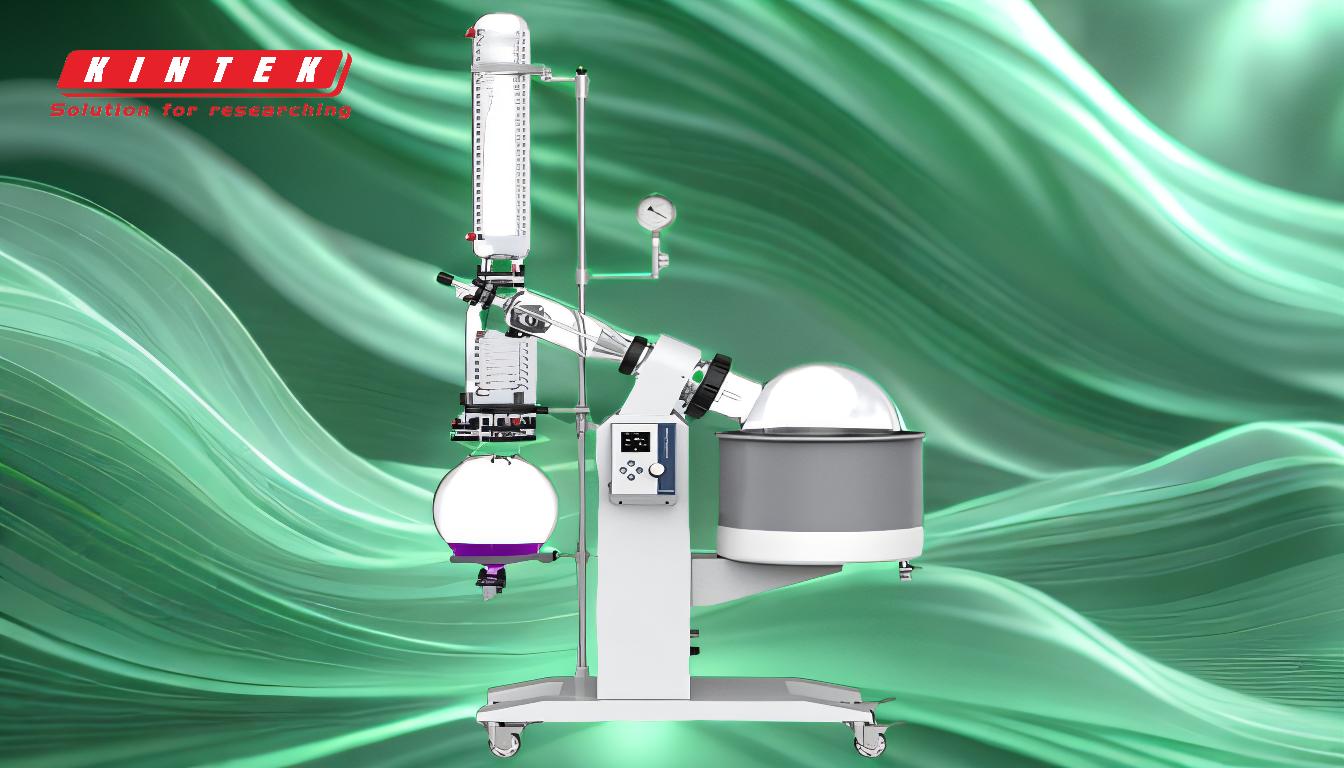A rotary evaporator is a sophisticated laboratory device used primarily for the efficient and gentle removal of solvents from samples by evaporation. Its structure is designed to optimize the separation of solvents from mixtures under reduced pressure and controlled temperature. The main components include a motor unit, a vacuum system, a heated fluid bath, a condenser, and various flasks for evaporation and collection. These components work together to ensure effective solvent separation, making the rotary evaporator an essential tool in chemical laboratories.
Key Points Explained:

-
Motor Unit:
- Function: The motor unit is responsible for rotating the evaporation flask. This rotation increases the surface area of the liquid, promoting even mixing and faster evaporation.
- Importance: By rotating the flask, the motor ensures that the sample is uniformly exposed to heat and vacuum, which enhances the efficiency of the evaporation process.
-
Vacuum System:
- Function: The vacuum system reduces the pressure within the evaporation flask, which lowers the boiling point of the solvent. This allows for evaporation at lower temperatures, minimizing the risk of thermal degradation of heat-sensitive samples.
- Components: Typically includes a vacuum pump or aspirator connected to the condenser via vacuum tubing.
- Importance: The vacuum system is crucial for enabling the evaporation of solvents at temperatures below their normal boiling points, which is particularly important for preserving the integrity of sensitive compounds.
-
Heated Fluid Bath:
- Function: The heated fluid bath provides the necessary thermal energy to the evaporation flask, facilitating the evaporation of the solvent.
- Temperature Control: The bath is usually temperature-controlled, allowing precise regulation of the heat applied to the sample.
- Importance: Proper temperature control is essential to prevent overheating, which could damage the sample, or underheating, which would slow down the evaporation process.
-
Condenser:
- Function: The condenser cools the vaporized solvent, converting it back into a liquid form that can be collected.
- Types: Condensers can be equipped with a coil passing coolant or a 'cold finger' design.
- Importance: Effective condensation ensures that the solvent is efficiently recovered, minimizing loss and allowing for the collection of pure distillate.
-
Evaporation Flask and Receiving Flask:
- Evaporation Flask: This flask holds the sample mixture and is placed in the heated bath. It is typically a round-bottomed flask to withstand the vacuum and heat.
- Receiving Flask: The receiving flask collects the condensed solvent after it passes through the condenser.
- Importance: These flasks are critical for containing the sample and the recovered solvent, ensuring that the process is contained and that the solvent can be easily collected and analyzed.
-
Vapour Duct:
- Function: The vapour duct connects the evaporation flask to the condenser, allowing the vaporized solvent to travel from the flask to the condenser.
- Importance: This component ensures that the vapor is efficiently transferred without leakage, maintaining the vacuum and preventing contamination.
-
Mechanical or Motorized Mechanism:
- Function: This mechanism may include features like a bump trap to prevent splashing or foaming, and it can also include automated controls for the rotation speed and vacuum level.
- Importance: These mechanisms enhance the safety and efficiency of the evaporation process, particularly when dealing with volatile or foaming samples.
In summary, the rotary evaporator is a complex but highly effective piece of equipment designed for solvent removal under controlled conditions. Each component plays a vital role in ensuring the process is efficient, safe, and capable of handling a wide range of samples, from simple solvents to complex mixtures. Understanding the structure and function of each part is essential for optimizing the use of a rotary evaporator in laboratory settings.
Summary Table:
| Component | Function | Importance |
|---|---|---|
| Motor Unit | Rotates the evaporation flask for even mixing and faster evaporation | Ensures uniform exposure to heat and vacuum, enhancing efficiency |
| Vacuum System | Reduces pressure to lower solvent boiling points | Enables evaporation at lower temperatures, preserving sensitive compounds |
| Heated Fluid Bath | Provides thermal energy for solvent evaporation | Precise temperature control prevents overheating or underheating |
| Condenser | Cools vaporized solvent for collection | Recovers solvent efficiently, minimizing loss |
| Evaporation Flask | Holds the sample mixture during evaporation | Ensures containment and withstands vacuum and heat |
| Receiving Flask | Collects condensed solvent | Facilitates easy collection and analysis of recovered solvent |
| Vapour Duct | Transfers vaporized solvent to the condenser | Maintains vacuum and prevents contamination |
| Mechanical Mechanism | Includes features like bump traps and automated controls | Enhances safety and efficiency, especially for volatile or foaming samples |
Discover how a rotary evaporator can optimize your lab processes—contact us today for expert advice!
















